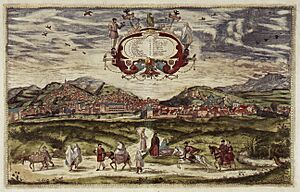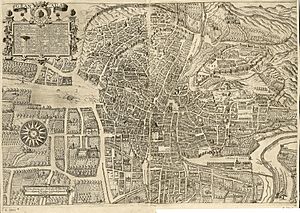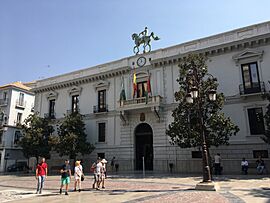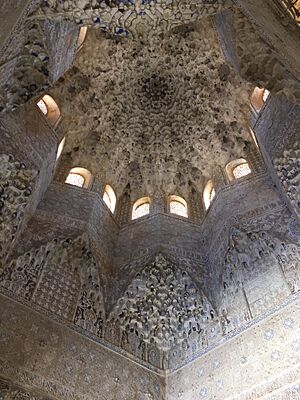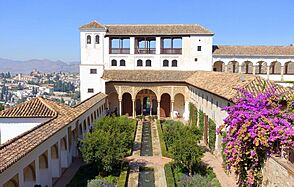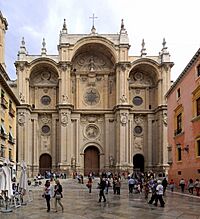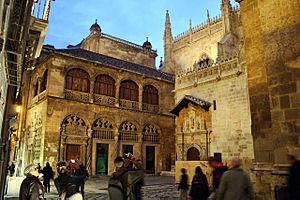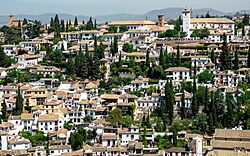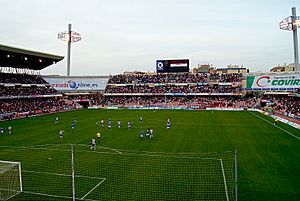Granada facts for kids
Quick facts for kids
Granada
|
|||
|---|---|---|---|
|
|||
| Country | Spain | ||
| Autonomous Community | Andalusia | ||
| Province | Granada | ||
| Government | |||
| • Type | Ayuntamiento | ||
| • Body | Ayuntamiento de Granada | ||
| Area | |||
| • Total | 88.02 km2 (33.98 sq mi) | ||
| Elevation
(AMSL)
|
738 m (2,421 ft) | ||
| Population
(2018)
|
|||
| • Total | 232,208 | ||
| • Density | 2,638.13/km2 (6,832.7/sq mi) | ||
| Demonyms | Granadan granadino (m.) and granadina (f.) |
||
| GDP | |||
| • Metro | €15.839 billion (2020) | ||
| Time zone | UTC+1 (CET) | ||
| • Summer (DST) | UTC+2 (CEST) | ||
| Postal codes |
18001–18019
|
||
| Area code(s) | +34 958 (Granada) | ||
Granada is a beautiful city in Andalusia, Spain. It's the capital of the Granada province. The city sits at the foot of the Sierra Nevada mountains. Four rivers meet here: the Darro, the Genil, the Monachil, and the Beiro.
Granada is about 738 meters (2,421 feet) above sea level. It's also only an hour's drive from the Mediterranean coast, known as the Costa Tropical. You can even find the Sierra Nevada Ski Station nearby, which hosted the FIS Alpine World Ski Championships 1996.
In 2021, Granada city had a population of 227,383 people. It's one of Spain's larger cities. The closest airport is Federico García Lorca Granada-Jaén Airport.
People have lived in this area for a very long time. Ancient groups like the Iberians, Romans, and Visigoths settled here. Granada became an important city in the 11th century during the Zirid Taifa of Granada. Later, in the 13th century, it became the capital of the Emirate of Granada. This was the last Muslim-ruled state in Spain.
In 1492, the Catholic Monarchs conquered Granada. It slowly became a Christian city over the 16th century.
The Alhambra is a famous medieval palace and fortress in Granada. It's a top example of Islamic architecture and one of Spain's most visited places. You can still see Islamic and Moorish architecture in the Albaicín neighborhood. The 16th century also brought beautiful Mudéjar and Renaissance architecture. Later, Baroque styles became popular.
The University of Granada is a big university with about 47,000 students. The pomegranate fruit (granada in Spanish) is a symbol of the city.
Contents
- What's in a Name? The Etymology of Granada
- Granada's Past: A Journey Through History
- Granada's Location and Weather
- People and Places: Demographics and Districts
- Granada's Economy: What the City Produces
- Education and Transportation in Granada
- Granada's Rich Culture: Heritage, Food, and Fun
- Historical Sites and Landmarks
- The Alhambra: A Royal Fortress and Palace
- Generalife: A Beautiful Summer Palace
- Granada Cathedral: A Grand Christian Church
- Royal Chapel: Resting Place of Monarchs
- Albayzín: A Historic Neighborhood
- Sacromonte: The Gypsy Caves and Flamenco
- Granada Charterhouse: A Monastery of Art
- Mosque of Granada: A Modern Landmark
- Palace of the Marqués de Salar: Renaissance Beauty
- Other Important Places to Visit
- Granada's Delicious Food: Gastronomy
- Fun and Entertainment in Granada
- Green Spaces: Parks and Gardens
- Sports in Granada
- Historical Sites and Landmarks
- Famous People from Granada
- Sister Cities: Granada Around the World
- Images for kids
- See also
What's in a Name? The Etymology of Granada
The historical Arabic name for Granada was Ġarnāṭa. The exact meaning and origin of this name are not fully known. It was used before the 11th century.
One idea is that Gárnata or Karnata meant "hill of strangers" or "hill of pilgrims." It might even come from the Berber language. Another idea is that it comes from the Latin word granum. This means "seed," "beads," or a "scarlet color." The Arab historian Al-Maqqari thought it came from the Latin word for pomegranate, granata.
The Latin word might have also referred to the "red" color of the soil and buildings in the area. This is similar to how the name of the Alhambra might have come about.
Granada's Past: A Journey Through History
Granada has a long and interesting history, shaped by many different cultures.
Ancient Beginnings: Before the Umayyads
People have lived in the Granada area since at least 5500 BC. Old tools and buildings show that the city's site was settled in the Bronze Age. The oldest ruins are from an ancient town called Ilturir. The Iberian tribe of the Bastetani founded it around 650 BC. This settlement later became known as Iliberri or Iliberis.
In 44 BC, Iliberis became a Roman colony. By 27 BC, it was a Roman town called Florentia Iliberritana, meaning 'Flourishing Iliberri'. Modern digs show a Roman town existed on the Albaicín hill.
The Rise of Granada: Early Islamic Period
In 711 AD, the Umayyad conquest of Hispania brought much of Spain under Muslim rule. This new land was called al-Andalus. Early Arabic writings mention a town called Madīnat Ilbīra (Elvira). It was the most important settlement in the area.
A smaller town and fortress called Ġarnāṭa (Granada) was also there. It was on the south side of the Darro River, or where the Albaicín neighborhood is today. This smaller town had many Jewish people, so it was also known as Gharnāṭat al-Yahūd ("Gharnāṭa of the Jews").
In the early 11th century, the Zirids, a Berber group from North Africa, took control. Their leader, Zawi ben Ziri, started an independent kingdom called the Taifa of Granada. He is often seen as the founder of the city of Granada.
Because Madīnat Ilbīra was hard to defend, the Zirid ruler moved his home to the higher area of Ġarnāṭa. This former Jewish town quickly became one of the most important cities in al-Andalus. It had a mix of Christians, Muslims, and Jews.

The Zirids built their fortress and palace, the al-Qaṣaba al-Qadīma ("Old Citadel"), on the Albaicín hill. The city grew around it and was protected by walls. Parts of these walls and two gates, Puerta Monaita and Arco de las Pesas, still exist. The city had a good water system with underground cisterns and pipes.
Under the Zirid kings, a Jewish administrator named Samuel ibn Naghrillah became very powerful. He was in charge of many important things, including the army. Granada became a center for Jewish culture and learning. Famous Jewish scholars visited or lived there. After Samuel's death, his son Joseph took over. However, his actions led to the 1066 Granada massacre, which ended the Golden age of Jewish culture in Spain.
From the late 11th to early 13th centuries, two North African empires, the Almoravids and then the Almohads, ruled Granada. The city did well under the Almoravids but declined under the Almohads.
The Nasrid Emirate: Granada's Golden Age
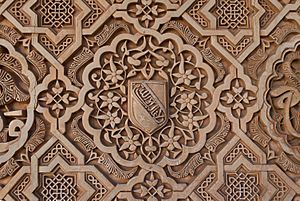
In 1228, the last effective Almohad ruler left Spain. Local leaders took over. The Christian kingdoms of Castile and Aragon were conquering many Muslim lands. But Ibn al-Ahmar (Muhammad I) started the Nasrid rule. This was the last and longest-lasting Muslim dynasty in Spain.
Ibn al-Ahmar sometimes worked with the Christian King Ferdinand III. Granada became a state that paid tribute to Castile, though wars often broke out. The Nasrids sometimes helped Castilian kings, and Castilians sometimes helped Nasrid leaders.
Many Muslim refugees came to Granada from lands conquered by Christians. This made the emirate small but very populated. The city grew, with new neighborhoods like Albaicín and Antequeruela. New walls were built, with Puerta de Elvira as a main entrance.
The city's main mosque was where the Granada Cathedral is now. The main market was the qaysariyya (now the Alcaicería). The only major madrasa (Islamic school) in al-Andalus, the Palacio de la Madraza, was founded in 1349. Other buildings from this time include the Corral del Carbón (an old inn) and the Maristan (a hospital).
Ibn Al-Ahmar moved the royal palace from the Albaicín hill to the Sabika hill. This is where he started building the Alhambra. The Alhambra was like a city within a city, with its own mosque, baths, fortress, and homes. The most famous palaces, like the Comares Palace and the Palace of the Lions, were built by Yusuf I and Muhammad V in the 14th century.
Granada's economy focused on trading valuable goods. It traded with Italian cities like Genoa, and also with other parts of Spain. It connected with Muslim trade centers, especially for gold from Africa. Granada also exported silk and dried fruit.
Granada was an important center for Islamic learning and culture. Famous scholars like Ibn Khaldun worked there. The traveler Ibn Battuta visited Granada in 1350. He called it the "metropolis of Andalusia and the bride of its cities."
The End of Muslim Rule and Changes in the 16th Century

On January 2, 1492, the last Muslim ruler, Emir Muhammad XII (also known as "Boabdil"), gave up control of the Emirate of Granada to the Catholic Monarchs (Ferdinand II of Aragon and Isabella I of Castile). This marked the end of Muslim rule in Spain.
The surrender agreement, the Treaty of Granada, allowed Muslims to keep their faith and customs. However, this promise was not kept. Jewish people were forced to convert or leave within three years. This was soon changed by the Alhambra Decree, which forced all Jews in Spain to convert or be expelled within four months. Those who converted were called conversos.
By 1499, Cardinal Francisco Jiménez de Cisneros started forcing Muslims to be baptized. This created the converso class for Muslims. This went against the treaty and led to the Rebellion of the Alpujarras (1499–1501). After the rebellion, the treaty was cancelled. Granada's Muslims had to convert or leave. Most converted to stay, becoming moriscos. Both conversos and moriscos faced persecution.
Over the 16th century, Granada became more Catholic and Castilian. Many Christians moved in from other parts of Spain. In 1492, Granada had 50,000 people, mostly Muslims. By 1561, it had over 30,000 Christian immigrants and about 15,000 moriscos.
After 1492, many mosques were turned into churches. In 1531, Charles V founded the University of Granada on the site of the old madrasa.
In December 1568, another rebellion, the Second Morisco Rebellion, broke out. King Philip II then ordered most moriscos to be expelled from Granada. They were sent to other cities in Spain. The final expulsion of all moriscos from Spain happened between 1609 and 1614.
Granada's Later History and Today
In the 17th century, Granada's population stayed around 55,000. It was less important than cities like Seville and Madrid.
From 1810 to 1812, Napoleon's army occupied Granada during the Peninsular War. They used the Alhambra as a fort and damaged it. When they left, they tried to blow up the whole complex. A Spanish soldier, José Garcia, saved what remained by disabling the fuses. In 1830, Washington Irving lived in Granada and wrote Tales of the Alhambra. This book made people around the world interested in southern Spain and its Islamic buildings.
In the 1930s, Granada saw tensions that led to the Spanish Civil War. When the war started in 1936, Granada joined the Nationalist side. There was resistance from working-class people in the Albaicín, which was put down violently. In the 1950s and 1960s, Granada was one of Spain's poorest areas. But in recent decades, tourism has become a very important industry for the city.
Granada's Location and Weather
Where is Granada Located?

Granada is in the Vega de Granada, a flat area within the Baetic mountains. The fertile soil of the Vega is great for farming. It gets water from streams that come from the Sierra Nevada mountains. The Genil River flows through the city center. The Monachil River also passes through Granada and joins the Genil.
What is Granada's Climate Like?
Granada has a hot-summer Mediterranean climate. Summers are hot and dry. Daily temperatures average 34°C (93°F) in July, but can go over 40°C (104°F). Winters are cool and damp, with most rain from November to January. January is the coldest month, with daytime temperatures around 13°C (55°F) and night temperatures around 1°C (34°F). Frost is common, and snow happens rarely. Spring and autumn have mild to warm temperatures.
People and Places: Demographics and Districts
Granada's Urban Areas
The municipality of Granada has five main urban areas: Granada city, Alquería del Fargue, Bobadilla, Cerrillo de Maracena, and Lancha del Genil. Cerrillo de Maracena has become part of Granada city as it has grown.
| Urban areas | Population | Location | Distance to Granada city (Km) |
|---|---|---|---|
| Alquería del Fargue | 505 | 37°12′21″N 3°35′45″W / 37.20583°N 3.59583°W | 8 |
| Bobadilla | 385 | 37°11′29″N 3°38′37″W / 37.19139°N 3.64361°W | 5 |
| Cerrillo de Maracena | 1,946 | 37°12′08″N 3°37′35″W / 37.20222°N 3.62639°W | 5 |
| Granada (city) | 227,383 | 37°10′34″N 3°35′52″W / 37.17611°N 3.59778°W | 0 |
| Lancha del Genil | 1,556 | 37°09′48″N 3°33′52″W / 37.16333°N 3.56444°W | 7 |
Granada's Population
In 2021, Granada had 231,775 people. About 46% were men and 54% were women. Since the 1990s, the population of Granada city has slightly decreased. People have moved to smaller towns nearby.
Here's a quick look at the age groups:
- People under 20 years old make up 19% of the population.
- People between 20 and 40 years old make up 23%.
- People between 40 and 60 years old make up 29%.
- People over 60 years old make up 29%.
| Demographic evolution of Granada from 1900–2021 |
|
EasyTimeline 1.90
|
| Population (1900–2021) of Granada (municipality), from National Statistics Institute (INE) (Spain) census. |
People from Other Countries
In 2021, 18,455 people living in Granada were from other countries. This is about 8% of the total population. Many come from Morocco (4,890), China (1,047), Senegal (947), Colombia (889), Italy (854), and Bolivia (763).
Exploring Granada's Neighborhoods

Realejo: The Old Jewish Quarter
Realejo was the Jewish neighborhood when the Nasrids ruled Granada. Because the Jewish population was so important, Granada was sometimes called "Granada of the Jews." Today, Realejo has many traditional Granadan houses called Los Cármenes. These homes have beautiful gardens that open onto the streets.
Cartuja: Home to a Monastery and University
This district is named after the Carthusian monastery, Cartuja. This old monastery started in a late Gothic style. It has amazing Baroque decorations inside. Many buildings for the University of Granada were also built in this area.
Bib-Rambla: A Lively Square
The name Bib-Rambla comes from an old gate called Bab al-Ramla. Today, Bib-Rambla is a great place for food, with many restaurants and outdoor seating. The Arab market, the Alcaicería, has narrow streets that start here and go to the cathedral.
Sacromonte: The Gypsy Caves and Flamenco
The Sacromonte neighborhood is on a hill next to the Albaicín. It became famous in the 19th century for its Gitano (Romani) people. This area is known for its unique cave houses, which are dug into the hillside. Sacromonte is a major center for flamenco music and dance, especially the Zambra Gitana, an Andalusian dance. The Centro de Interpretación del Sacromonte works to protect this special culture.
Zaidín: A Large and Diverse Area
Zaidín is Granada's largest neighborhood, with 100,000 residents. It used to be a working-class area but is now more upscale. Many residents are from North and West Africa, China, and South American countries. Every Saturday morning, Zaidín hosts a big outdoor market where people sell fruits, vegetables, clothes, and other goods.
Granada's Economy: What the City Produces
Granada produces many farm products like barley, wheat, sugarcane, and tobacco. Farmers also grow olives, oranges, lemons, figs, almonds, and pomegranates. The city also refines sugar. Vineyards and wines are important to the city and region. In 2020, Granada exported $1.3 billion worth of products.
Education and Transportation in Granada
Learning in Granada: Education Opportunities
University Education
The University of Granada (UGR) was founded in 1531 by Charles V. It continued the tradition of higher learning from the old Madraza, which was there when Granada was a Muslim kingdom. The university is known worldwide for its teaching and research. It's a popular place for exchange students from the Erasmus Program. It's also the fourth-largest Spanish university by student numbers, with about 47,000 undergraduate students.
Compulsory Education
Granada has 69 schools for compulsory secondary education. There are 104 centers for infant and primary education, including private and public schools. The city also has five adult education centers.
Getting Around Granada: Transport Options
Metro System
Construction of the Granada metro (light rail) started in 2007. It was delayed by Spain's economic crisis. Service finally began on September 21, 2017. The single line goes through Granada and connects to the towns of Albolote, Maracena, and Armilla.
Bus Services
The main company for bus transport in Granada is Transportes Rober. You can also take buses to and from the airport with the company Alsa.
Train Connections
Granada railway station connects to many cities in Spain by train. There are different types of train services:
- Short-distance trains
- Medium-distance trains
- Long-distance trains
- AVE (high-speed long-distance) trains use the Antequera–Granada high-speed rail line. The closest AVE connection is at Antequera-Santa Ana railway station.
Taxi Services
Granada has many taxis to help travelers. Official Granada taxis are white with a green stripe.
Airport Access
The closest airport is Federico García Lorca Airport, about 15 km (9 miles) west of Granada.
Public Transport Use in Granada
On a weekday, people in Granada spend about 42 minutes using public transport for their commute. About 9% of riders spend more than 2 hours on public transport each day. The average wait time at a stop is 10 minutes. The average distance for a single trip is 2.7 km (1.7 miles).
Granada's Rich Culture: Heritage, Food, and Fun
Historical Sites and Landmarks
Granada is famous for its many historical buildings and monuments.
The Alhambra: A Royal Fortress and Palace
The Alhambra is a huge palace and fortress on the Sabika hill. It overlooks Granada city. It's one of the most famous examples of Islamic architecture. It's also one of the best-preserved palaces from the historic Muslim world. It even has great examples of Spanish Renaissance architecture. The Alhambra is a top tourist spot in Spain and a UNESCO World Heritage Site since 1984.
Construction started in 1238 by Muhammad I Ibn al-Ahmar, the first Nasrid emir. It was built on the site of older forts. Later Nasrid rulers kept adding to it, especially Yusuf I and Muhammad V in the 14th century. During this time, the Alhambra was like its own city, separate from Granada below. It had a mosque, public baths, roads, houses, workshops, and a complex water system.
As a royal city, it had at least six main palaces. The most famous ones are the Mexuar, the Comares Palace, the Palace of the Lions, and the Partal Palace. These are what visitors see today. The Alcazaba fortress is at the western tip and was key for defense. The architecture of the Nasrid palaces shows the style of Moorish architecture. Decorations are mostly inside, with tile mosaics on lower walls and carved stucco on upper walls. Geometric patterns, plant designs, and Arabic writing are common. Muqarnas, which look like "stalactites," were used for vaulted ceilings.
After the Christian conquest in 1492, the Alhambra became the Royal Court of Ferdinand and Isabella. Christopher Columbus even got support for his journey here. The palaces were partly changed. In 1526, Charles V ordered a new Renaissance-style palace, the Palace of Charles V. It was never finished. Other Renaissance additions from Charles V's time include the Emperor's Chambers.
In the 18th century, the Alhambra was neglected. French troops damaged parts of it in 1812. In the 19th century, travelers like Washington Irving "rediscovered" it. His book, Tales of the Alhambra (1832), brought international attention to the site. The Alhambra has been restored many times since the 19th century, and work continues today.

Generalife: A Beautiful Summer Palace
The Generalife is a Nasrid-era summer palace located just east of the Alhambra. It was built by Muhammad II and Muhammad III in the late 13th and early 14th centuries. This palace has several rectangular garden courtyards with decorated buildings at each end. It was once connected to the Alhambra by a walled path. Later Nasrid rulers also made changes to it.
Christian builders made big changes to the Generalife in the 16th century, adding Renaissance elements. In the 20th century, new landscaped gardens called the Jardines Nuevos ('New Gardens') were added. These gardens mix Italian and Moorish styles. An outdoor theater was also added in 1952. Like the Alhambra, the Generalife is a major tourist attraction and a UNESCO World Heritage Site since 1984.
Granada Cathedral: A Grand Christian Church
The cathedral of Granada is built over the site of the old Nasrid Great Mosque. Its construction began in the early 16th century, soon after the conquest of Granada. The Catholic Monarchs ordered the work. It was first planned in a Gothic style, but the architect Diego Siloe changed it to a full Renaissance style in 1529.
The cathedral has five naves instead of the usual three. Later, Alonso Cano added Baroque elements to the main front in 1664. The main chapel has praying statues of the Catholic Monarchs. The church's tabernacle and holy area are considered a masterpiece of Spanish Baroque art.
Royal Chapel: Resting Place of Monarchs
The Catholic Monarchs chose Granada as their burial place in 1504. The Royal Chapel of Granada was built over the old Great Mosque's terrace. Here, the Catholic Monarchs, their daughter Joanna of Castile, and her husband Philip I of Castile are buried. Construction started in 1505. The chapel mixes Gothic and Renaissance styles. Over time, it collected many works of art and religious items.
The Royal Chapel is a Historic Artistic Monument. Important parts include its main retable, grid, and vault. The Sacristy-Museum holds the Catholic Monarchs' treasures. Its art gallery has works from Flemish, Italian, and Spanish artists.
-
Hans Memling – Diptych of Granada, left wing: Acceptance of the Cross, h. 1475
-
Juan de Flandes – Birth of Christ, 1435–1438
-
Sandro Botticelli – Prayer of the Garden, 1498–1500
Albayzín: A Historic Neighborhood
This historic neighborhood is on the hills north of the Alhambra. It still has much of its medieval street plan from the Nasrid period. People lived on this hill as early as the 7th century BC. During the early Islamic period, it was a small settlement called Gharnāṭa. In the 11th century, it became one of the most important cities in Al-Andalus. The city's main fortress was here. Later, it became known as Albaicín.
After Granada was conquered in 1492, the district changed. Mosques were replaced with new churches, often in a mix of Mudéjar and Renaissance styles. Examples include the Church of Santa Ana and the Church of San Cristóbal. Some churches, like San Salvador, still have parts of old mosques. New buildings like the Royal Chancellery were also built.
In the 16th century, most of the city's morisco population lived in the Albaicín. After the 1568 rebellion and their expulsion, the district became less populated. Many Christian residents expanded their homes into carmens. These are traditional houses with gardens. Some houses, like Casa de Zafra, date back to the Nasrid period. In 1994, the Albaicín became a UNESCO World Heritage Site, along with the Alhambra. It still has parts of the 11th-century Zirid city walls, the 14th-century Nasrid walls, the Bañuelo (an old Islamic bathhouse), and many old water cisterns.
Sacromonte: The Gypsy Caves and Flamenco
The Sacromonte neighborhood is on Valparaíso hill. It's known as the old neighborhood of the Romani (Gypsies), who settled in Granada after the city was conquered. It's famous for its whitewashed cave houses dug into the rock. You can still hear guitars playing flamenco music here. It's a very popular tourist spot in Granada.
At the top of the hill is the Abbey of Sacromonte. It was built in the 17th century to guard relics. The abbey complex includes catacombs, the abbey building, and colleges. The church inside is simple but has beautiful art. It includes the Crucificado de Risueño, which is very important to the Romani people. The abbey also has a museum.
Granada Charterhouse: A Monastery of Art
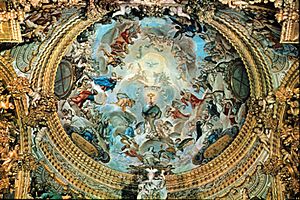
The Charterhouse of Granada is a monastery for monks. It's located on what was once a Muslim farm with lots of water and fruit trees. The idea to build it came from Gonzalo Fernández de Córdoba. Construction started in 1516 and continued for 300 years.
The monastery was damaged during the Peninsular War. Today, it belongs to the Carthusians. The entrance is an ornate arch. Inside, a large courtyard leads to the church. The church has three entrances and one main nave. It features beautiful retables by Juan Sánchez Cotán. The chancel has glass doors decorated with mother-of-pearl and rare woods.
The church's tabernacle and holy area are considered a masterpiece of Baroque Spanish art. The dome above this area has frescoes by Antonio Palomino. The courtyard has arches and a fountain. The Chapter House of Legos is the oldest building, from 1517.
Mosque of Granada: A Modern Landmark
The Mosque of Granada opened in 2003 on the Albaicín hill. It was built near the Church of San Salvador and the Church of San Nicolás. The land was bought in 1981, but it took many years to get approval. Funding came from Malaysia, Morocco, and the United Arab Emirates. The mosque serves about 500 people today.
Palace of the Marqués de Salar: Renaissance Beauty
The Palace of the Marqués de Salar is on Carrera del Darro, a famous street in Granada. This palace is a great example of classical Granada architecture from the 16th century Renaissance period. It was built by the Marqués de Salar, a descendant of important historical figures. Today, the palace is the El Patio de los Perfumes museum. It has 1,500 square meters (16,146 sq ft) of space and a lovely patio with flowers and perfumes.
Other Important Places to Visit

- Monasterio de San Jerónimo (16th-century Monastery of Saint Jerome)
- San Juan de Dios Hospital (historic hospital)
- Palacio de la Madraza (remains of a 14th-century Islamic school)
- Archaeological Museum of Granada (located in the 16th-century Castril Palace)
- Museo de Bellas Artes de Granada (Museum of Fine Arts)
- El Bañuelo (11th or 12th-century bathhouse)
- Corral del Carbón (14th-century caravanserai, an old inn)
- Cuarto Real de Santo Domingo (13th-century palace)
- Palacio de los Olvidados (16th-century house and museum with historical instruments)
- Church of San Salvador (16th-century church, with parts of a 13th-century mosque)
There is also a monument honoring Judah ben Saul ibn Tibbon in Granada.
Granada's Delicious Food: Gastronomy
Granada's food is part of the Arabic-Andalusian cooking tradition. It has strong Arab and Jewish influences. You can see this in the spices used, like cumin, coriander, nutmeg, and cinnamon. Raisins, almonds, and honey are also common.
The different climates in the province, from the coast to the Sierra Nevada mountains, mean there's a wide variety of ingredients. These include vegetables, meats, sausages, and fish.
The famous Trevélez ham comes from the Sierra of Granada. Other pork products like chorizo and black pudding are also popular.
One of Granada's most typical dishes is beans with ham. Another well-known dish is the Sacromonte tortilla. It includes cooked brains and veal. "Papas a lo pobre" (poor man's potatoes) are fried potatoes usually served with egg, fried peppers, and pieces of pork or ham.
For stews, the pot of San Antón is popular in January. Other stews include cabbage stew, green beans and fennel stew, and gypsy pottery.
Granada is also known for its sweets, often made by nuns in the city's convents. These include pestiños, puff pastries, ovos moles, and sweet potato rolls. Many sweets, like aljojábanas (honey and cheese dumplings) and almond cake, have Arabic roots.
Unlike other parts of Andalusia, tapas (small snacks) are usually free in Granada's bars and restaurants. Going "bar hopping" for tapas is a popular tradition among locals.
Fun and Entertainment in Granada
Granada offers many fun activities for both visitors and locals.
- The Zambras of Sacromonte: These are old wedding parties held by the Romani people. They take place in the cave houses of the Sacromonte neighborhood. They are a unique part of flamenco culture. You can also find other flamenco shows in the Albaicín.
- Festivals: Granada hosts many festivals throughout the year. These include the International Music and Dance Festival, International Jazz Festival, Granada Festival South Cinemas, and International Tango Festival.
- Concerts and Shows: There's a regular program of concerts at the Manuel de Falla Auditorium. You can also see theater and opera performances at the Congress Palace.
- Parties: Many parties are held throughout the year to celebrate religious, civic, or cultural events.
Green Spaces: Parks and Gardens
Granada has many beautiful parks and gardens, including:
|
Sports in Granada
Granada has a football (soccer) team:
- Granada CF, which plays in La Liga
Granada also has a basketball team:
- Fundación CB Granada, which plays in Liga ACB
Skiing is popular nearby:
- The city hosted the FIS Alpine World Ski Championships 1996.
Bullfighting:
- Granada has a bullring called Plaza de toros de Granada, which can hold 14,507 people.
Famous People from Granada
Many notable people have come from Granada, including:
- Ibn al-Khatib (1313–1374), a poet and historian
- Alonso Cano (1601–1667), a famous painter, sculptor, and architect
- Mariana Pineda (1804–1831), a heroine for freedom
- Federico García Lorca (1898–1936), a world-renowned poet and playwright
- Miguel Ríos (born 1944), a famous rock singer
- Manuel Orantes (born 1949), a professional tennis player
- María José Rienda Contreras (born 1975), a ski racer
Sister Cities: Granada Around the World
Granada is twinned with these cities:
- Aix-en-Provence, France (1979)
- Tetuán, Morocco (1988)
- Tlemcen, Algeria (1989)
- Coral Gables, Florida, United States (1989)
- Freiburg im Breisgau, Germany (1991)
- Marrakech, Morocco (1994)
- Belo Horizonte, Brazil (2002)
- Sharjah, United Arab Emirates (2009)
Images for kids
-
Mosaic from a Roman villa, dating from 1 AD, discovered in the district of Los Mondragones in Granada (now kept at the Archaeological Museum)
-
Map showing the Emirate of Granada by Ottoman cartographer Piri Reis
See also
 In Spanish: Granada para niños
In Spanish: Granada para niños












